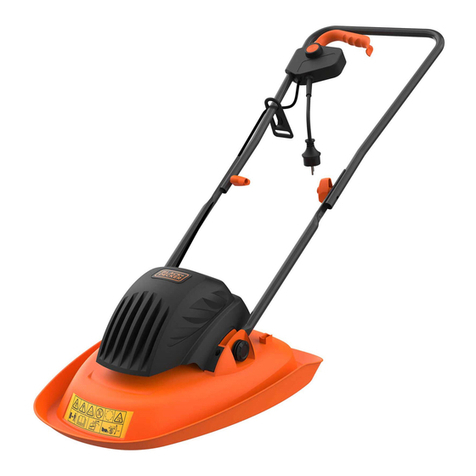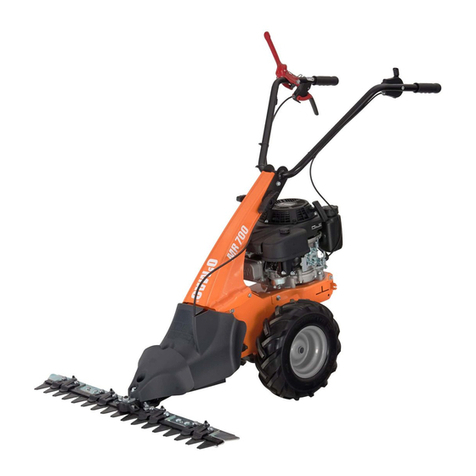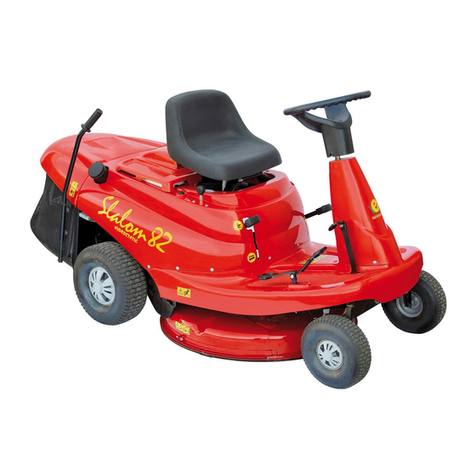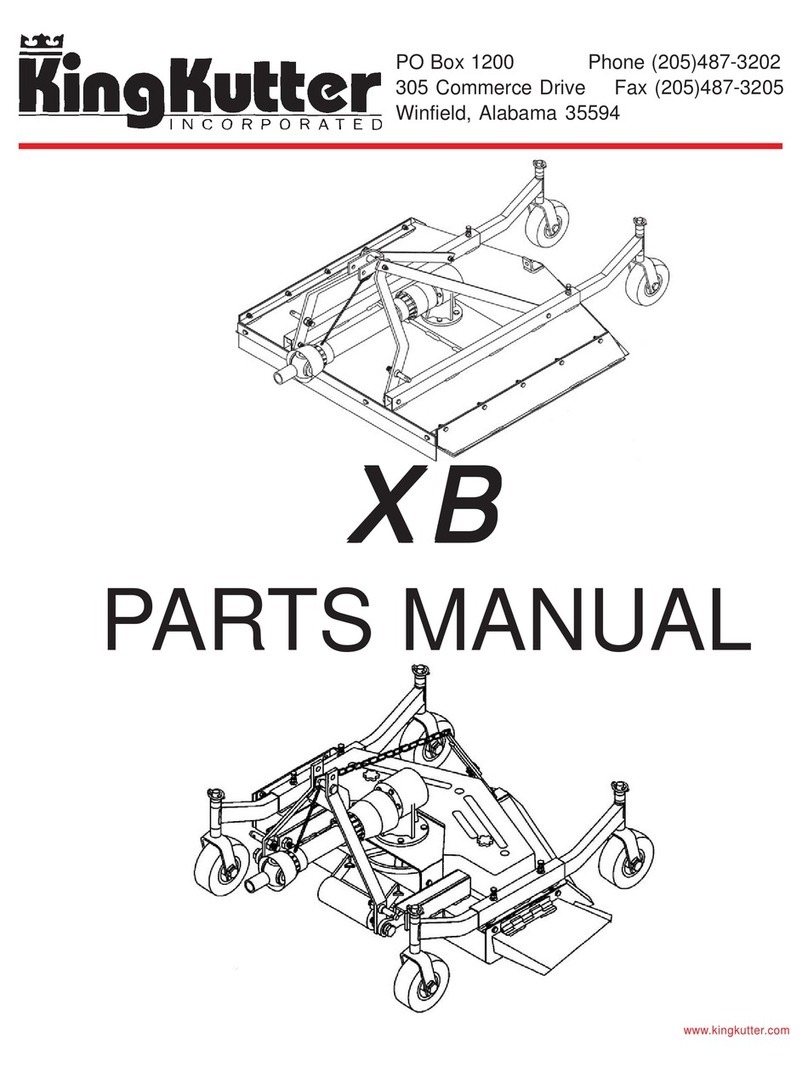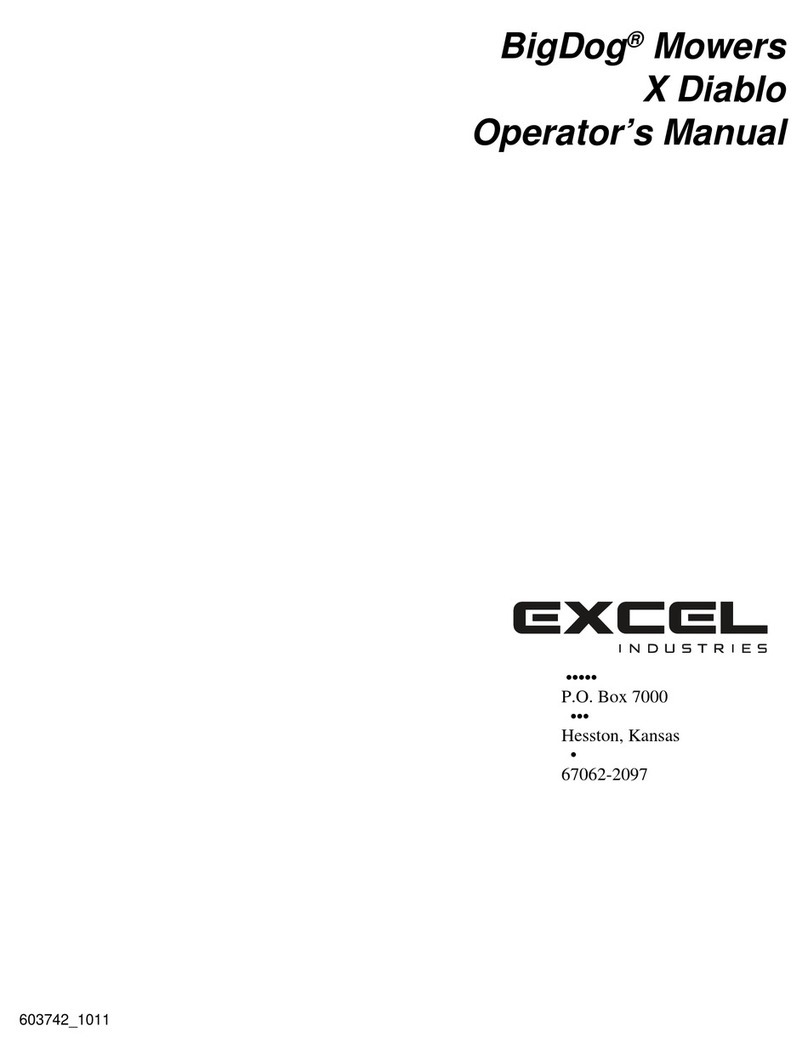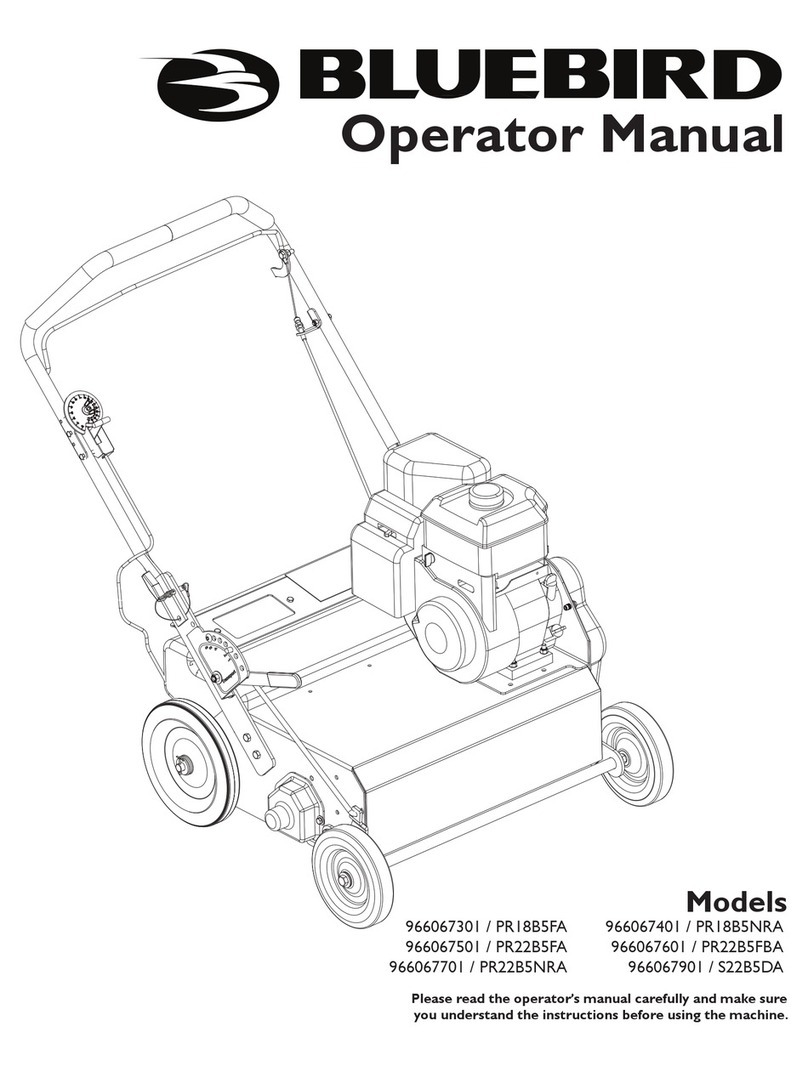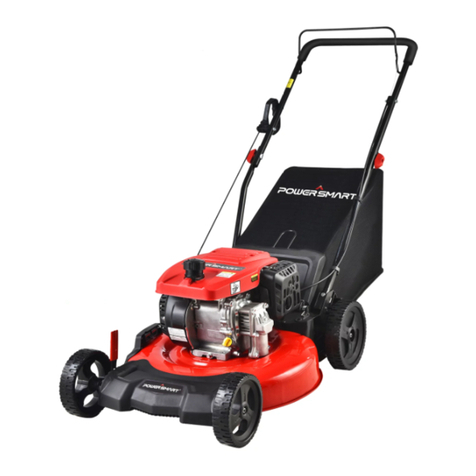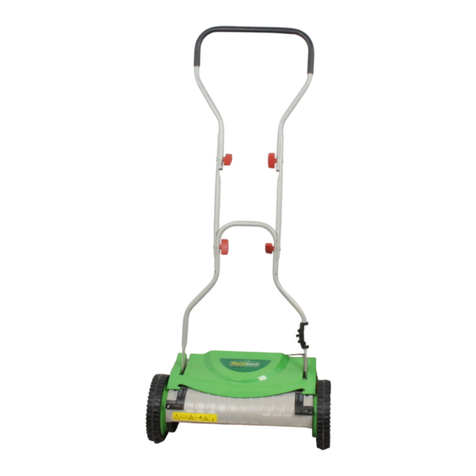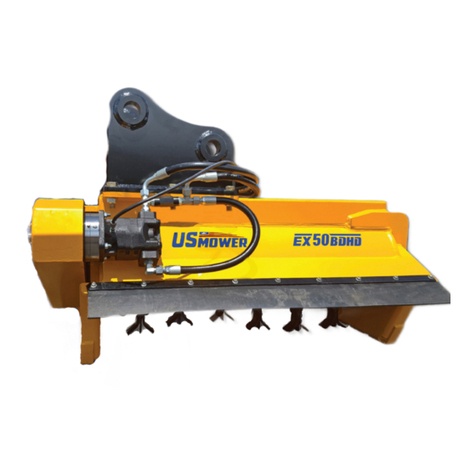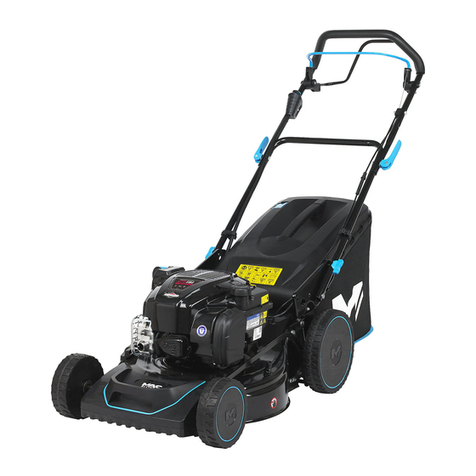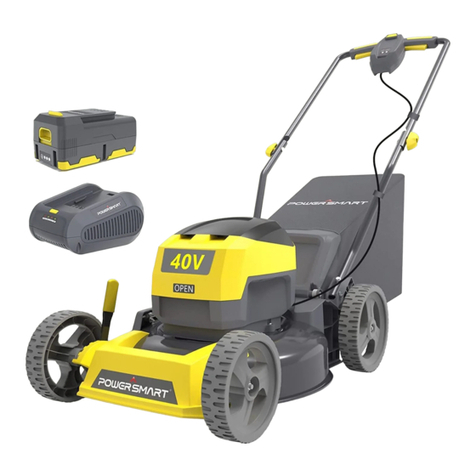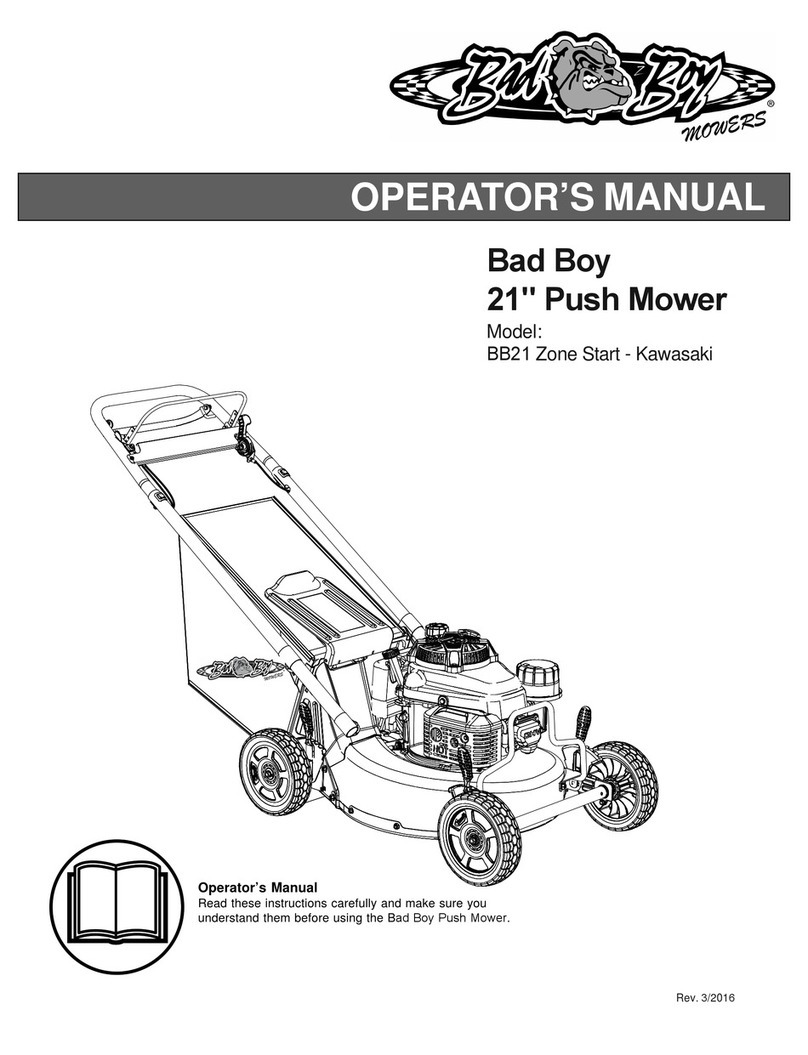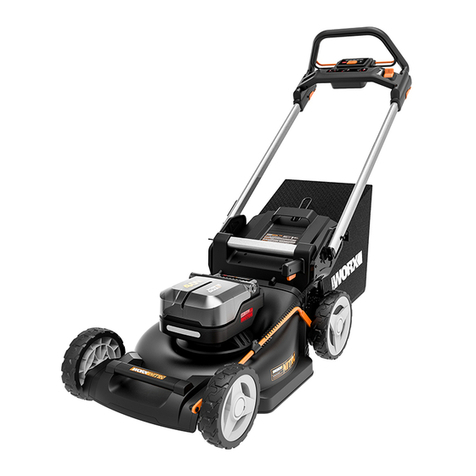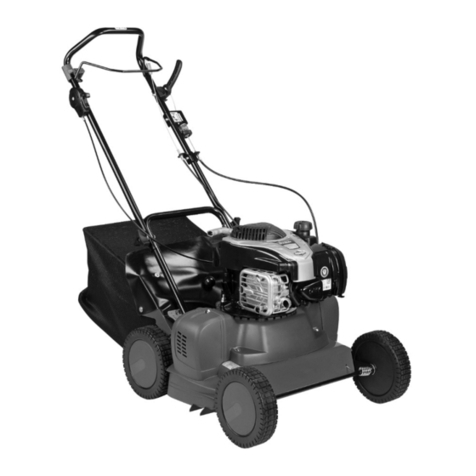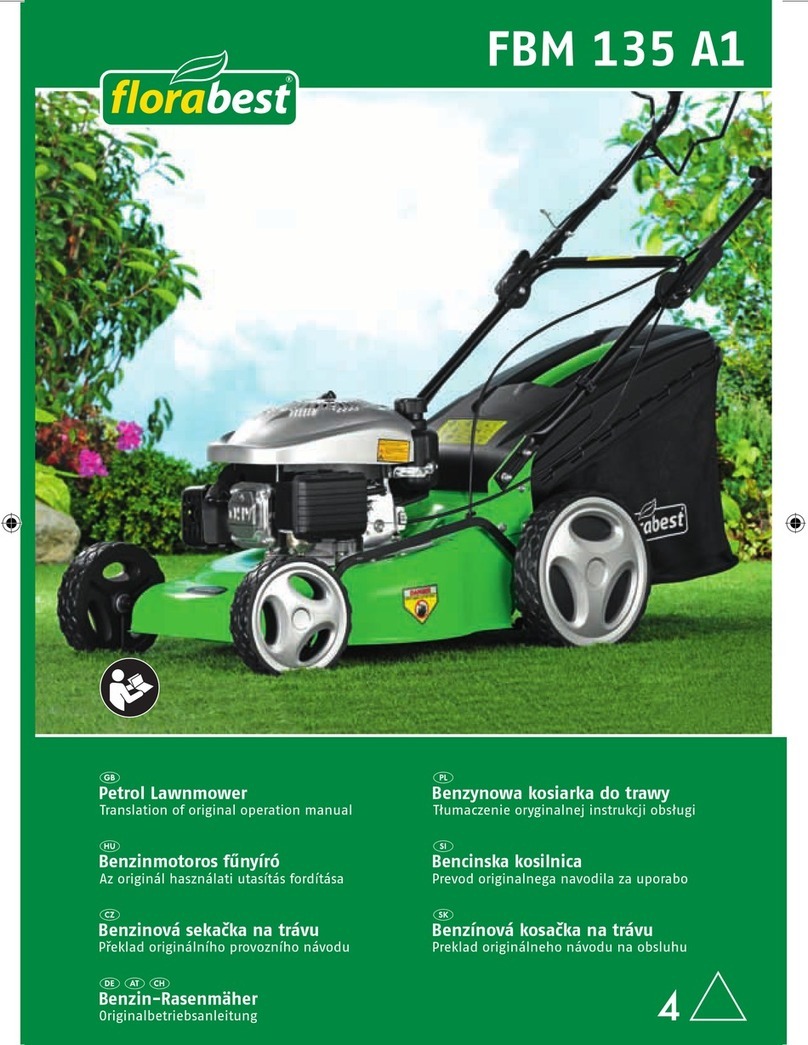GreenWorks Commercial CZ52R User manual

CZ52R/ CZ60R/ PZ52R / PZ60/R
EN OPERATOR MANUAL
FR MANUEL D’OPÉRATEUR
Zero-Turn Mower
Zero-Turn Mower
ES MANUAL DEL OPERADORZero-Turn Mower
www.GreenworksCommercial.com

1 Description.........................................2
1.1 General information...........................................2
1.2 Overview........................................................... 2
2 Read all instructions......................... 3
2.1 Operator.............................................................3
2.2 Machine............................................................. 3
2.3 Mowing area......................................................3
2.4 Mowing..............................................................4
2.5 Servicing............................................................4
2.6 Slope operation..................................................4
2.7 Child safety........................................................4
2.8 Use a ramp.........................................................5
2.9 Towing...............................................................5
2.10 Battery and charger............................................5
3 Symbols on the product.................... 6
4 Risk levels...........................................6
5 Environmentally safe battery
disposal...............................................7
6 Proposition 65....................................7
7 Know your machine..........................7
7.1 Control panel..................................................... 7
7.2 Steering control levers.......................................8
7.3 Safety start interlock system..............................8
7.4 ROPS (Roll Over Protective Structure).............9
7.5 Anti-scalp Wheels..............................................9
7.6 Neutral bypass knob.......................................... 9
8 Operation.........................................10
8.1 Before operation.............................................. 10
8.2 Operate the machine........................................ 11
8.3 Slope operation................................................13
9 Electrical system..............................14
9.1 Electrical system safety................................... 14
9.2 Electrical system information..........................14
9.3 Battery and charger..........................................14
9.4 Digital display..................................................15
9.5 Faults............................................................... 16
10 Fault code (For CZ series)..............17
11 Fault code (For PZ series).............. 24
12 Maintenance.....................................30
12.1 Mower blade maintenance...............................30
12.2 Tires.................................................................31
12.3 Lubrication.......................................................31
12.4 Torque values...................................................31
12.5 Seat belt maintenance......................................31
12.6 ROPS maintenance..........................................32
12.7 Battery maintenance........................................ 32
12.8 Lithium energy module maintenance.............. 32
12.9 Service............................................................. 32
13 Cleaning and storage.......................33
13.1 Clean the machine........................................... 33
13.2 Store the machine............................................ 33
14 Troubleshooting...............................34
15 Technical data..................................35
16 Limited warranty............................ 36
17 Slope guide....................................... 38
16.1 What is covered by this warranty.................... 35
16.2 Who must perform the warranty service......... 36
16.3 What is not covered by this warranty..............36
16.4 Disclaimer of warranty....................................36
16.5 Limitation of remedies.....................................36
16.6 Time limit........................................................ 36
16.7 No other warranties......................................... 37
16.8 Owner's responsibility..................................... 37
16.9 Allocation of risks........................................... 37
16.10 Warranty registration....................................... 37
1
English EN
P0802464-00 v1.2

1 DESCRIPTION
1.1 GENERAL INFORMATION
This manual applies to the following Greenworks
Commercial lines:
1.1.1 TO THE NEW OWNER
The purpose of this manual is to assist owners and operators
in maintaining and operating this Greenworks Commercial
mower. Please read the entire manual carefully; the
information and instructions provided can help you achieve
years of dependable machine performance.
It is the owner’s responsibility to make certain that the
operators and mechanics read and understand this manual and
all decals before operating this machine. It is also the owner’s
responsibility to make certain that the operators and
mechanics are qualified and physically able to operate this
equipment. All operators and mechanics must become
familiar with the safe operation of this equipment, its controls
and safety signs.
Never let children or untrained people operate or service this
equipment. Please note that local regulations may restrict the
age of the operator.
1.1.2 USE THIS MANUAL
General operation, adjustment and maintenance guidance is
outlined for both the experienced and novice Greenworks
Commercial Mower user. Operating conditions vary
considerably and cannot all be addressed individually.
Through experience, however, operators should have no
difficulty developing good operating skills suitable to most
conditions.
Directions used in this manual (e.g., "RIGHT" or "LEFT")
refer to directions when either seated on the mower or
standing facing forward, unless otherwise stated.
Photographs and illustrations used were current at the time of
printing, but subsequent production changes may cause your
machine to vary slightly in detail. Greenworks Commercial
Products reserves the right to redesign and change the
machine as deemed necessary, without notification. If a
change has been made to your machine which is not reflected
in this owner’s manual or the parts manual, see your
Greenworks Commercial Products dealer for current
information and parts.
1.1.3 WARRANTY REGISTRATION
The owner must register the unit by filling out the Warranty
Registration Form, provided in the owner’s packet, to validate
warranty protection. As the new equipment owner, you are
expected to see that this is done at the time of delivery. If
using the Warranty Registration Form, it MUST be completed
and signed by the authorized dealer and original purchaser.
Be sure to register the mower plus each attachment that
displays a model and serial identification number plate with
Greenworks Commercial.
WARNING
Any unauthorized modification, alteration, or use of non-
approved attachments voids the warranty and releases
Greenworks Commercial from any liability arising from
subsequent use of this equipment.
1.1.4 WARRANTY REGISTRATION
The mower serial number is found on the date label. The
serial number and model are required on the Warranty
Registration Form. They will also ensure that you receive the
correct parts when replacement becomes necessary.
1.1.5 PARTS AND SERVICE
All warranty repair and service must be handled through an
authorized Greenworks Commercial Products dealer.
Arrangements should be made through your local service
center.
1.2 OVERVIEW
1ROPS (Roll Over Protective Structure)
2Steering control levers
3Safety belt
4Left control panel
5Right control panel
6Deck
7Anti-scalp wheels
8Front wheel
9Drive wheel
10 Key of battery pack protection
11 Battery pack protection
12 Charging port
13 Discharge chute
2
English
EN
P0802464-00 v1.2

2 READ ALL INSTRUCTIONS
WARNING
This symbol indicates important safety instructions. If these
instructions are not followed, it could endanger the personal
safety and/or property of the operator and others. Read and
understand all instructions in this manual before attempting
to operate the mower. Failure to comply with these
instructions may result in personal injury.
DANGER
This mower was built to be operated according to the rules
for safe operation that are contained in this manual. As with
any type of power equipment, carelessness or error on the
part of the operator can result in serious injury. This mower
is capable of amputating body parts and throwing objects.
Failure to observe the following safety rules could result in
serious injury or death.
WARNING
Basic safety precautions should always be followed when
using lawnmowers in order to reduce the risk of fire,
electric shock, and personal injury.
WARNING
Use of this mower should be restricted to individuals who
have read and understand and will follow the warnings and
instructions that are printed in this manual and on the
mower.
WARNING
• Carefully read all instructions on the mower and in the
manual before attempting to assemble and operate the
mower.
• For safe operation, read, understand, and follow all
instructions in this manual.
• Become familiar with all controls and their proper
operation. Know how to stop the mower and how to
disengage the power in an emergency.
• Keep this manual in a safe place for reference and
consult it regularly.
2.1 OPERATOR
• Only allow responsible, capable adults who are familiar
with the instructions to operate this machine.
• Safe operation requires your full attention and
capabilities.
• Always look where you are going and be aware of your
surroundings.
• Listen to the machine and be aware of any change.
•Feel-the machine and its responses from both your inputs
and the environment.
• Remain-focused on your task.
• Always wear proper eye protection that complies with the
latest safety standards in order to reduce the risk of eye
injury while operating or performing any adjustment or
repair. See ANSI Z87.1.
• Do not operate machine unless discharge guard or other
safety devices are in place and working.
•Always wear a face mask or a dust mask while operating
the mower in a dusty environment.
• Always dress properly. The wearing of protective gloves
and safety footwear is recommended.
• Do not wear radios or music headphones while operating
the machinery.
• Do not operate the equipment while wearing sandals,
tennis shoes, sneakers, shorts or any type of loose-fitting
clothing. Long hair, loose clothing or jewelry may get
tangled in moving parts. Always wear long pants, safety
glasses, ear protection and safety shoes while operating
this machine.
• Stay alert! Do not operate the mower when you are tired.
Do not operate the mower while under the influence of
alcohol or drugs. Pay attention to what you are doing. Use
common sense.
• Never carry passengers.
• Follow the manufacturer's recommendation for wheel
weights or counterweights.
2.2 MACHINE
• Never operate a poorly maintained machine.
• Always keep safety shields and covers in place.
• Follow daily and weekly checklists, making sure
electrical connections are secured and bolts are tightened.
• Replace damaged parts immediately.
• Never operate mower without a proper trail shield,
discharge cover, switch control, or other safety device in
place and in working order. Do not operate the mower
with damaged safety devices; doing so can result in
injury.
• Repair or replace any damaged components before
restarting and operating the lawnmower.
• Inspect lawnmower cord periodically and if damaged,
have it repaired by an authorized service facility.
• Only use approved replacement parts.
• When using, keep out of water, extended periods of direct
sunlight, and do not expose to rain.
• Always store your lawnmower indoors. When not in use,
the mower should be stored indoors in a dry and locked
place, out of reach of children.
2.3 MOWING AREA
• Before mowing any area, thoroughly inspect the area for
any hazards. Walk the area to ensure there is adequate
traction and no holes, drop-offs, or hidden objects that
could cause issues. Clear the area of objects such as
rocks, wire, toys, etc., which could be thrown by the
blades.
3
English EN
P0802464-00 v1.2

• Be sure the area is clear of bystanders before operating.
Stop machine if anyone enters the area.
• Plan your mowing pattern in such a way as to avoid
discharging material toward roads, sidewalks, bystanders,
vehicles, windows, etc. Do not discharge material against
a wall or obstruction. Doing so may cause the discharged
material to ricochet back toward the operator.
• Do not mow anything but grasses.
• Stop the blades when crossing dirt, gravel, or paved
surfaces.
• Avoid dangerous environments. Do not operate the
mower in the rain or in wet or damp grass. To reduce the
risk of electric shock, do not expose to water or operate
on wet ground.
2.4 MOWING
• For riding mower models, always remain seated while
operating machine.
• Do not operate on inclines greater than 15 degrees.
• Mow only in daylight or in good artificial light. Never
rush a mowing job.
• Never attempt high-speed maneuvering, especially in
crowded, congested areas or on slopes.
•In order to avoid contact with the blade or injury caused
by a thrown object, stay in the operating zone behind the
handles, and keep children and bystanders at least 100ft
(30m) away from the mower while it is in operation. Stop
the motor immediately if someone enters the mowing
area.
• Look down and behind before and while moving
backwards.
• Slow down before turning.
• Do not mow in reverse unless absolutely necessary.
• When moving in reverse, SLOWLY pull right and left
Drive Control Levers rearward and avoid sudden
movements. Rapid movement of the Drive Control
Levers in either direction could result in a reaction of the
machine that can cause serious injury.
• Do not put hands or feet near rotating parts or under the
cutting deck. Contact with the blade can amputate hands
and feet.
• If the mower starts to vibrate excessively, stop the motor
and check for the cause immediately. Excessive vibration
is generally a sign the mower is not functioning properly.
• Stop the motor and wait until the blade comes to a
complete stop before unclogging the chute. The cutting
blade will continue to rotate for a few seconds after the
motor is shut off. Do not place any part of your body in
the blade area until you are sure that the blade has
stopped rotating.
• Disengage blade(s) when not mowing. Shut off engine
and wait for all parts to come to a complete stop before
cleaning the machine or unclogging the discharge guard.
• If lawnmower strikes a foreign objects, stop the machine,
rotate the ignition switch to "OFF" position, then, if it is
safe, inspect for damage.
• Don't force the lawnmower.
•Do not use the mower for any job except that for which it
is intended.
2.5 SERVICING
•Turn off the machine before servicing or removing blade.
• Do not reach under blade guard. Keep hands, feet, and
clothing way from rotating blades.
• To reduce risk of injury to persons, remove battery pack
when not in use.
•To reduce personal risk and damage to the machine, never
clean with pressure washer.
• Maintain your mower. Keep cutting edges sharp and
clean to ensure the best performance and safe operation.
• Remove or disconnect battery before servicing, cleaning
or removing material from lawnmower.
2.6 SLOPE OPERATION
Slopes are a major factor related to loss of control and tip-
over accidents, which can result in severe injury or death.
Operation on all slopes requires extra caution. If you cannot
back up the slope or if you feel uneasy on it, do not mow it.
• Mow up and down slopes, not across.
• Watch for holes, ruts, bumps, rocks, or other hidden
objects. Uneven terrain could overturn the machine. Tall
grass can hide obstacles.
• Choose a low ground speed so you will not have to stop
or shift while on a slope.
• Do not mow on wet grass. Tires may lose traction.
• Always keep the machine in gear when going down
slopes. Do not shift to neutral and coast downhill.
• Avoid starting, stopping, or turning on a slope. If the tires
lose traction, disengage the blade(s) and proceed slowly
straight down the slope.
• Keep all movement on slopes slow and gradual. Do not
make sudden changes in speed or direction, which could
cause the machine to roll over.
• Use extra care while operating machine with attachments;
they can affect the stability of the machine. Do not use on
steep slopes.
• Do not try to stabilize the machine by putting your foot
on the ground.
• Do not mow near drop-offs, ditches or embankments. The
machine could suddenly roll over if a wheel goes over the
edge or if the edge caves in.
2.7 CHILD SAFETY
Tragic accidents can occur if the operator is not aware of the
presence of children. Children are often attracted to the
machine and the mowing activity. Never assume that children
will remain where you last saw them.
• Never leave machine unattended with key in switch,
especially with children present.
4
English
EN
P0802464-00 v1.2

• Keep children out of the mowing area and under the
watchful care of a responsible adult other than the
operator.
• Do not allow children under the age of 14 to operate this
mower. Children who are 14 years of age and older must
read and understand the operating instructions and safety
rules in this manual, and must be trained and supervised
by a parent.
•Always disengage deck blade switch and turn key to
“OFF” position and remove key.
• Stay alert, and turn the mower off if a child or any other
person enters the mowing area.
• Use extreme care when approaching blind corners,
doorways, shrubs, trees, or other objects that may obscure
your view of a child who may run into the path of the
mower.
• Before and while backing, look behind and down for
small children.
• Never carry children on the mower with you, even with
the blade(s) shut off. They may fall off and be seriously
injured or interfere with safe machine operation. Children
who have been given rides in the past may suddenly
appear in the mowing area for another ride and be run
over or backed over by the machine.
2.8 USE A RAMP
• Use extreme caution when loading and unloading this
mower onto a truck or trailer with a ramp.
• Use only a single, full-width ramp. This provides a
surface for the mower frame to contact if the unit starts to
tip backwards. It also reduces the risk of a wheel going
off and the machine tipping over.
•Do not exceed a 15-degree angle between the ramp and
the ground or between the ramp and the trailer or truck.
• Become familiar with the mower’s controls and confident
in its smooth operation before attempting to drive it up or
down a ramp.
• Use slow drive mode and drive carefully.
• Avoid any sudden movement of the controls and use only
slow, even acceleration.
2.9 TOWING
• Tow only with a machine that has a hitch designed for
towing. Do not attach towed equipment except at the
hitch point.
•Follow the manufacturer’s recommendation for weight
limits for towed equipment and towing on slopes.
•Never allow children or others in or on towed equipment.
• On slopes, the weight of the towed equipment may cause
loss of traction and loss of control.
• Travel slowly and allow extra distance to stop.
2.10 BATTERY AND CHARGER
• Do not recharge batteries in a confined or unvented area.
• Do not smoke, strike a match, or cause a spark in the
vicinity of the battery during charging.
• Store indoors, and do not expose to rainwater. Avoid
storing in direct sunshine.
• Do not charge batteries in rain or in wet location.
• Double insulation - When servicing, use only identical
replacement parts.
• Only to be used with Greenworks Commercial 82V
Batteries (2919002). See Parts Manual.
• Electrical maintenance should be performed by trained
professionals ONLY
2.10.1 BATTERY
• Battery-operated mowers and tools do not have to be
plugged into an electrical outlet; therefore, they are
always in operating condition. Be aware of possible
hazards when not using your battery-operated mower or
when changing accessories. Following this rule will
reduce the risk of electric shock, fire, or serious personal
injury.
• Do not place battery-operated machines or tools -- or the
batteries themselves -- near fire or heat. This will reduce
the risk of explosion and possibly injury.
• Do not crush, drop or damage battery pack. Do not use a
battery pack or charger that has been dropped or received
a sharp blow. A damaged battery is subject to explosion.
Properly dispose of a dropped or damaged battery
immediately..
• Batteries can explode in the presence of a source of
ignition, like a pilot light. To reduce the risk of serious
personal injury, never use any cordless product in the
presence of an open flame. An exploded battery can
propel debris and chemicals. If exposed, flush with water
immediately. Do not charge battery tool in a damp or wet
location. Following this rule will reduce the risk of
electric shock.
• For best results, your battery-operated machine should be
charged in a location where the temperature is more than
0°C (32° F) but less than 45°C (113° F). To reduce the
risk of serious personal injury, do not store outside or in
vehicles.
• Under extreme usage or temperature conditions, batter y
leakage may occur. If this liquid comes in contact with
your skin, wash immediately with soap and water. If
liquid gets into your eyes, flush them with clean water for
at least 10 minutes, then seek immediate medical
attention. Following this rule will reduce the risk of
serious personal injury.
• When battery pack is not in use, keep it away from other
metal objects like paper clips, coins, keys, nails, screws,
or other small metal objects that can make a connection
from one terminal to another. Shorting the battery
terminals together may cause sparks, burns, or a fire.
• Battery posts, terminals, and related accessories may
contain lead and lead compounds, chemicals known to
the State of California to cause cancer and reproductive
harm. Wash hands after handling.
5
English EN
P0802464-00 v1.2

• Charge batteries in an open, well-ventilated area away
from spark and flames. Unplug charger before connecting
or disconnecting battery to/from the charging port.
Always wear safety glasses and protective clothing/gear.
Use insulated tools.
•Sparks can cause a battery gas explosion, which will
result in serious personal injury. Prevent the battery
terminals from touching any metal mower parts when
removing or installing the battery. Do not allow metal
tools to short between the battery terminals and metal
mower parts. Use insulated tools. Always keep protective
battery cover and rear cover in place.
• Explosive gases from batteries can cause serious injury,
or death. Poisonous battery fluid contains sulfuric acid;
contact with skin, eyes or clothing can cause severe
chemical burns.
• Follow first aid directions for contact with battery fluid.
Get medical attention immediately.
• Incorrect battery cable routing could cause damage to the
mower and battery cables. This can cause sparks, which
can cause a battery gas explosion that will result in
serious personal injury.
• Do not open or mutilate the battery. Mutilated batteries
can release corrosive electrolytes which can cause
damage to the eyes or skin. It may be toxic if swallowed.
3 SYMBOLS ON THE PRODUCT
Some of the following symbols may be used on this tool.
Please study them and learn their meaning. Proper
interpretation of these symbols will allow you to operate the
tool better and safer.
Symbol Name Explanation
V Volt Voltage
A Amperes Current
Hz Hertz Frequency (cycles per sec-
ond)
W Watt Power
min Minutes Time
/min Per Minute
Revolutions, strokes, sur-
face speed, orbits etc., per
minute
Direct Current Type or a characteristic of
current
n
o
No Load
Speed Rotational speed, at no load
Safety Alert Precautions that involve
your safety.
WARNING
--- Wet Con-
ditions
Do not expose the product
to rain or moist conditions.
Symbol Name Explanation
Read Opera-
tor’s Manual
To reduce the risk of injury,
user must read and under-
stand operator’s manual be-
fore using this product.
Eye Protec-
tion
Always wear eye protection
with side shields marked to
comply with ANSI Z87.1
when operating this equip-
ment.
DANGER ---
Keep Hands
and Feet
Away
To reduce the risk of injury,
keep hands and feet away
from rotating parts. Do not
operate unless discharge
cover or grass bag is in its
proper place. If damaged,
replace immediately.
DANGER ---
Steep Slope
Hazard
Use extra caution on slopes.
do not mow slopes greater
than 15 degrees.
DANGER ---
Thrown Deb-
ris
Remove objects that can be
thrown by the blade in any
direction. Wear safety
glasses.
DANGER ---
Keep By-
standers Away
Keep all bystanders at least
100 ft. away.
Look around Always look where you are
going and be aware of your
surroundings.
Keep children
away
Never carry children on the
mower with you.
No Reach Do not reach hands or feet
under mower deck.
4 RISK LEVELS
The following signal words and meanings are intended to
explain the levels of risk associated with this product.
SYM-
BOL
SIGNAL MEANING
DANGER Indicates an imminently haz-
ardous situation,which, if not
avoided, will result in death
or serious injury.
WARNING Indicates a potentially hazard-
ous situation,which, if not
avoided, could result in death
or serious injury.
6
English
EN
P0802464-00 v1.2

SYM-
BOL
SIGNAL MEANING
CAUTION Indicates a potentially hazard-
ous situation, which, if not
avoided, may result in minor
or moderate injury.
CAUTION (Without Safety Alert Sym-
bol) Indicates a situation that
may result in property dam-
age.
5 ENVIRONMENTALLY SAFE
BATTERY DISPOSAL
The toxic and corrosive materials below are in the batteries
used in this machine: Lithium-Ion, a toxic material.
WARNING
Discard all toxic materials in a specified manner to prevent
contamination of the environment. Before discarding
damaged or worn out Li-ion battery, contact your local
waste disposal agency, or the local Environmental
Protection Agency for information and specific instructions.
Take the batteries to a local recycling and/or disposal center,
certified for lithium-ion disposal.
WARNING
If the battery pack cracks or breaks, with or without leaks,
do not recharge it and do not use. Discard it and replace
with a new battery pack. DO NOT TRY TO REPAIR IT! To
prevent injury and risk of fire, explosion, or electric shock,
and to avoid damage to the environment:
• Cover the terminals of the battery with heavy-duty
adhesive tape.
• DO NOT try to remove or destroy any of the battery
pack components.
• DO NOT try to open the battery pack.
• If a leak develops, the released electrolytes are
corrosive and toxic. DO NOT get the solution in the
eyes or on skin, and do not swallow it.
• DO NOT put these batteries in your regular household
trash.
• DO NOT incinerate.
• DO NOT put them where they will become part of any
waste landfill or municipal solid waste stream.
• Take them to a certified recycling or disposal center.
6 PROPOSITION 65
WARNING
This product contains a chemical known to the state of
California to cause cancer, birth defects or other
reproductive harm. Some dust created by power sanding,
sawing, grinding, drilling, and other construction activities
contains chemicals known to cause cancer, birth defects or
other reproductive harm. Some examples of these chemicals
are:
• Lead from lead-based paints;
•Crystalline silica from bricks and cement and other
masonry products;
• Arsenic and chromium from chemically treated lumber.
Your risk of exposure to these chemicals varies depending
on how often you do this type of work. To reduce your
exposure to these chemicals, work in a well-ventilated area,
and work with approved safety equipment, such as dust
masks that are specially designed to filter out microscopic
particles.
Save these instructions.
7 KNOW YOUR MACHINE
7.1 CONTROL PANEL
7.1.1 LEFT CONTROL PANEL
For CZ series
For PZ series
# Name Function
14 Digital dis-
play
This display shows important electrical
system information. Refer to the Electri-
cal section for complete information.
7
English EN
P0802464-00 v1.2

# Name Function
15 Master pow-
er ignition
switch
A two position switch: OFF and ON.
With key inserted, rotate it clockwise to
the ON position; conterclockwise to OFF
position.
7.1.2 RIGHT CONTROL PANEL
For CZ series
For PZ series
# Name Function
16 Power
ON/OFF for
accessory
(ETO)
The machine can be used together with
other attachments such as blower and
snow thrower.
17 ON/OFF for
blade (PTO)
This switch engages the deck motors.
Pull the switch up to engage and push
switch down to disengage the motors.
18 High/Low
for blade
speed
High blade mode is a higher blade speed
for cutting thicker grass, while low blade
mode provides lower blade speed for
lower battery consumption on thinner,
drier grass areas.
NOTE
Mowing time will be increased when
mowing in low blade mode.
# Name Function
19 High/Low
for driving
speed
Allows operators to select a comfortable
driving speed. Pressing it to “High
Speed"” position means that the maxi-
mum drive speed will be 10 mph. Press-
ing it to “Low Speed” position means
that the maximum drive speed will be
5.5 mph. Press it to “Low Speed” posi-
tion for inexperienced operators or when
trimming around objects, buildings and
other obstacles.
NOTE
Get comfortable with mower before us-
ing “High Speed” setting. The maxi-
mum speed may be adjusted at any
time, whether the mower is in motion
or not.
20 ON/OFF for
LED lights For CZ-seriers mower: The work light
will light up automatically when light
cannot be fully sensed by photo-diode,
and it will go out when light can be
sensed by photo-diode.
For PZ seriers mower: Press the LED
light button to light up the work light.
NOTE
The light can not serve as the drive
light, just as the work light.
IMPORTANT
Never engage deck motors when the deck is under load.
Motors or deck could be damaged.
7.2 STEERING CONTROL LEVERS
The two levers control the mower’s speed, direction,
stopping, neutral lock, and park brake. Levers are used to
steer, accelerate, decelerate, stop, and change direction. When
the control levers are in the park brake position, the mower
will not move when the drive system is operating.
7.3 SAFETY START INTERLOCK
SYSTEM
The machine is equipped with a safety start interlock system
consisting of the park brake switches, seat switch, and deck
blades ON and OFF switch.
The mower’s safety start interlock system is also designed to
protect the operator and others from accidental injury due to
unintentional traction drive system starting.
8
English
EN
P0802464-00 v1.2

Check mower safety start interlock system daily, prior to
operation. This system is an important mower safety feature.
It should be repaired immediately if it malfunctions. Call
Greenworks Commercial immediately. The machine
incorporates a separate seat switch which will stop the drive
system and deck motors when the operator is unseated for any
reason while the mower is operating. This is a safety feature
designed to prevent runaway or accidental entanglement.
WARNING
The safety interlock system must not be disconnected or
bypassed. Doing so could cause the machine to operate
unexpectedly, resulting in personal injury.
To inspect the system:
1. The operator must be on the seat when testing the seat
switch.
2. Turn the master power ignition switch to the ON position
with key.
3. Keep steering control levers in neutral position.
4. Pull the deck blades ON and OFF switch to engage the
motor.
5. Slowly raise off of the seat. The deck blade system should
stop.
6. If the deck blade system fails to stop when the operator is
off of the seat and if the cause cannot be
determined,contact your Greenworks dealer immediately.
7.4 ROPS (ROLL OVER PROTECTIVE
STRUCTURE)
A ROPS may minimize the chance of injury or death from
rollover. The two-post ROPS can be pivoted down by
removing the clevis pins (21) after pulling out on the R-pins
(22) so that the machine can operate under low-hanging tree
limbs or other obstructions. Do not wear the seat belt when
the ROPS is in the lowered position. Use the ROPS in the
“folded” position only when it is absolutely necessary.
WARNING
Do not operate the mower with the ROPS folded (lowered
position) -- a standard operating mode. A folded ROPS does
not provide rollover protection.
WARNING
Always wear your seat belt unless the ROPS is folded
down. In this case, the seat belt should never be worn.
WARNING
To minimize chance of injury or death from rollover:
• Keep ROPS in the raised and locked position and use
the seat belt.
• Lower the ROPS only when absolutely necessary.
•Drive slowly and carefully. Raise the ROPS as soon as
clearance permits. Read and follow slope operation
instructions and warnings.
• Always fasten seat belt during operation of the machine
(mower equipped with ROPS in “raised/up” position).
• Inspect the area to be mowed for proper overhead
clearance (tree limbs, guy wires, doorways, etc.) Do not
contact any overhead object with the ROPS.
WARNING
Always pull from the tractor hitch. Do not attach chains or
ropes to the ROPS for pulling purposes, as the machine can
tip backwards.
7.5 ANTI-SCALP WHEELS
Anti-scalp wheel kits are standard on Greenworks
Commercial units. These anti-scalp wheels (23) are designed
to minimize scalping when mowing on rough, uneven terrain.
After setting the cutting height, adjust the anti-scalp wheels
so they extend below the deck but do not contact the ground.
They should always be at least 1/4" to 3/4" below the deck.
With the unit sitting on a flat level surface, the wheel position
can be adjusted up or down as needed from 3/4" to 1-3/4"
below the blade surface. Move the wheels up or down - using
the different axle mount holes in the wheel mount bracket (if
applicable on model).
7.6 NEUTRAL BYPASS KNOB
1. Locate the Neutral Bypass Knobs behind the frame at the
rear of the mower.
2. Remove the (4) thumb screws (24) holding in the mesh
cover.
9
English EN
P0802464-00 v1.2

3. Remove the neutral bypass knob from its original location
and install it to the motor (25). Operate one or both of the
knobs on the motor, as needed.
4. Rotate the neutral bypass knobs (26) clockwise to release
drive brakes; counterclockwise to engage.
5. Install the neutral bypass knob(s) (26) back to its/their
original location after completing maintenance.
WARNING
Never drive mower with the neutral bypass knob working.
Always install the neutral bypass knob to the original
position before driving! Failure to re-install the knob could
cause serious damage to your mower and void mower
warranty!
WARNING
Never pull the neutral bypass lever outside when the
machine is working on the slope!
8 OPERATION
8.1 BEFORE OPERATION
8.1.1 ADJUST THE SEAT
WARNING
Make sure seat pan is securely bolted down prior to each
use to prevent seat from moving/tilting in the event of
mower tipping or rollover.
The seat can be adjusted forward and rearward by moving the
latch under the seat. Move the latch to left and pull the seat
where you have the best control of the machine and are the
most comfortable and then tighten the safety belt.
27
8.1.2 ADJUST THE STEERING CONTROL
LEVER
The steering control levers (2) can be adjusted for operator
comfort. By loosening the cap screws (2-1) that attaches the
upper control lever (2-2) to the lower lever (2-3), the upper
control lever can be pivoted to fit the operator’s personal
preference. The steering control levers should be adjusted so
that they align with each other when in the neutral position.
2-2
2-1
2-3
8.1.3 ADJUST THE DECK CUTTING
HEIGHT
DANGER
Never attempt to make any adjustments to the mower deck
while the traction drive system is on or with the deck clutch
engaged. Mower blades cannot be seen and are located very
close to deck housing. Fingers and toes can be cut off
instantly.
Deck height is adjustable from 1" - 6" (3.33 cm - 20 cm).
Deck should be raised while mowing is in progress to avoid
stumps, rocks or other obstacle that can be damage mower
deck.
10
English
EN
P0802464-00 v1.2

28
29
1. Depress the deck height adjustment pedal (28).
2. Insert the pin (29) once the desired deck height is
available to lock the pedal.
NOTE
Full depress the deck height adjustment pedal to work
in the highest height, and the pedal will automatically
be locked.
8.2 OPERATE THE MACHINE
8.2.1 START THE MACHINE
WARNING
Seat belt must be fastened while operating a mower
equipped with ROPS in the raised and secured position. Do
not wear the seat belt when the ROPS is in the lowered
position.
1. With key inserted, turn master power ignition switch on
by rotating key clockwise to the ON position.
2. Check for the appropriate speed mode by pressing drive
speed control button to “low speed” position.
NOTE
It is always recommended to start out in low mode/slow
speed.
3. Pull right and left drive control levers inward until stops
are contacted.
4. Pull up on deck blades ON/OFF switch to start cutting
blades for mowing.
NOTE
Only engage blades when drive control levers are in the
NEUTURAL position! NEVER engage blades when
moving!!
5. Push drive control levers forward for forward motion and
pull for reverse motion.
NOTE
Electric brake will engage after drive control levers are
returned to neutral.
8.2.2 DRIVE THE MACHINE
After starting the traction drive system, engage the steering
control levers and steer as follows:
WARNING
Always be aware of what is behind the machine before
backing up. Do not mow in reverse unless absolutely
necessary. Always look down and behind before and while
backing up.
WARNING
Rapid movement of steering control levers is not
recommended as damage to the electrical system
components may occur.
•To go forward, push steering control levers forward an
equal distance.
•To go in reverse, pull steering control levers rearward an
equal distance.
•To turn left, move the right steering control lever farther
forward from neutral than the left steering control lever.
•To turn right, move the left steering control lever farther
forward from neutral than the right steering control lever.
•To execute a zero-radius turn, move one steering
control lever forward and the other steering control lever
back of neutral. This will allow the drive wheels to
counter-rotate.
•To stop or decrease speed, move steering control levers
to neutral. When going forward, pull back gently on
steering control levers. When going in reverse, push
forward gently on steering control levers.
•For an emergency stop, there are two methods that can
be used:
• When traveling forward or in reverse, place the
steering control levers in the park brake position
immediately. When moving in the rearward direction,
push forward gently on steering control levers and
avoid sudden movement. Any sudden movement
could cause the front of the mower to come off of the
ground, resulting in possible loss of control, thereby
causing serious injury or death.
• Turn the ignition key to the OFF position. This will
shut down the traction drive system and the deck
drive system.
•To make a three-point turn to the right, move the left
steering control lever farther forward from neutral than
the right steering control lever and start the turn. Next,
pull back on the steering control levers until they are past
neutral and the machine starts to go rearward. Pull the
right steering control lever farther rearward from neutral
than the left steering control lever until the rear of the
machine has pivoted around. Then, push the steering
control levers forward until they are both past neutral and
the machine starts to go forward. Push the left steering
control lever farther forward from neutral than the right
steering control lever and finish the turn.
11
English EN
P0802464-00 v1.2

•To increase speed, increase steering control lever’s
distance from neutral. The farther forward steering
control levers are from neutral, the faster the machine will
travel forward. The farther back steering control levers
are from neutral, the faster the machine will go in reverse.
8.2.3 STOP THE MACHINE
DANGER
Never make sudden stops or reverse direction, especially
when maneuvering on a slope. The steering is designed for
sensitive response. Rapid movement of the steering control
levers in either direction could result in a reaction of the
machine that can cause serious injury.
1. Return drive control levers to the Neutral/Park brake
position.
2. Push down on deck blades ON/OFF to turn off the blades.
3. Push drive control levers outward into park brake
position.
4. Rotate key in Master Power Ignition Switch
counterclockwise to the OFF position.
8.2.4 OPERATION SUGGESTIONS
DANGER
Prior to operation, the operator should be thoroughly
familiar with the proper use and operation of the equipment,
should read the manual completely and thoroughly, and
should have attempted slow moving maneuvers to become
familiar with the operation of the equipment before
attempting normalspeed operation. An inexperienced
operator should not mow on slopes or on uneven terrain.
WARNING
If you lose steering control while operating the machine,
place the steering control levers in the park brake position
immediately and turn key to the “OFF” position. Inspect the
machine and consult your Greenworks Commercial dealer
to resolve the problem before continuing to operate.
WARNING
The unit’s steering control levers are very responsive. For
smooth operation, move levers slowly, avoiding sudden
movements. Skill and ease of operation come with practice
and experience. The machine can spin very rapidly. Use
caution when making turns and slow down before making
sharp turns.
Inexperienced operators may have a tendency to oversteer
and lose control. Slow-moving practice maneuvers are
recommended to become familiar with these characteristics
before attempting normal-speed operation.
WARNING
Sharp depressions or raised obstacles (such as gutters or
curbs) should not be directly approached at high speed in an
attempt to “jump” them as the operator could be thrown
from the equipment. Approach at a slow speed and angle
one drive wheel at the obstruction. Continue at an angle
until the wheel clears and then pivot the opposite wheel
around.
When turning on soft, wet turf, keep both wheels rolling
either forward or backward. Pivoting on one stopped wheel
can damage turf. This is especially important when mowing.
Keep blades sharp. Many professional mowing companies
have additional sets of blades and change blades twice a day:
once in the morning and again at noon. Many problems with
incorrect cutting patterns are due to dull blades or blades
which have been sharpened incorrectly. Information on
sharpening blades is listed in this manual’s maintenance
section. In addition, most communities have individuals or
companies that specialize in sharpening mower blades. Blade
sharpness should be checked daily.
DANGER
Never work with blades while key is in the ignition switch.
Always place deck clutch switch in the disengaged position,
place steering control levers in the park brake position and
turn key to the OFF position and remove key from switch.
Block up mower when you must work under it. Wear gloves
when handling blades. Always check for blade damage if
mower strikes a rock, branch, or another foreign object
during mowing.
•Direct grass discharge to right, away from unmown
area. Select a mowing pattern that directs grass discharge
towards the outside the mowing area. Generally, this
means using a pattern utilizing left turns because side
discharge is to the right. In any case, avoid throwing grass
discharge onto unmowed area because grass is then
mowed “twice.” Mowing twice puts an unnecessary load
on the unit and reduces mowing efficiency.
•When mowing a lawn for the first time, cut grass
slightly longer than normal to avoid scalping uneven
terrain. When possible, it is best to use the cutting height
that was used in the past. When cutting grass taller than
six inches, you may want to mow the lawn twice to
achieve a better quality of cut.
•During normal mowing, cut only about 1/3 of the grass
blade. Cutting more than that is not recommended unless
grass is sparse or it is the end of the mowing season.
•Alternate mowing direction to keep the grass growing
straight and better dispersion of the clippings.
•Remember, grass grows at different rates at different
time of the year. Mow more often in the early spring to
maintain the same cutting height. As the growth rate
12
English
EN
P0802464-00 v1.2

slows in mid summer, mow less frequently. If you cannot
mow at a regular interval, mow at a high cutting height at
first, then mow again two days later at a lower cutting
height.
•Raise the cutting height of the mower if the cutting
width of the mower is wider than the previous mower.
This ensures that uneven turf is not cut too short.
•Raise the cutting height of the mower if the grass if
slightly taller than normal or if it contains a high degree
of moisture. Then mow it again with the cutting height set
lower. If the machine’s forward motion must be stopped
while mowing, a clump of grass clippings may drop onto
your lawn. To avoid this, move onto a previously cut area
with the blades engaged.
•Charge the battery immediately. If battery percentage is
higher than 2% and less than 5%, the maximum drive
speed will be 5.5 mph and the unit will in low blade
mode. If battery percentage is less than 2%, the working
blade will stop automatically. The unit should
immediately be returned to the battery charging area and
the unit connected to the battery charger.
•Allow motors 30-60 minutes to cool down. If drive
motor exceeds programmed temperature, the motor speed
will decrease. If temperature continues to increase, drive
will shut down at a higher programmed temperature.
8.3 SLOPE OPERATION
• Use extreme caution when operating on slopes.
• Do not remove or modify the stabilizer wheels.
• Watch for holes, ruts, bumps, rocks or other hidden
objects. Uneven terrain could overturn the machine. Tall
grass can hide obstacles.
• Remove obstacles such as rocks, tree limbs, etc.
• Keep all movement on slopes slow and gradual. Do not
make sudden changes in speed or direction.
• Avoid starting and stopping on a slope. If tires lose
traction, disengage the blades and proceed slowly straight
down the slope.
• Mow a safe distance (minimum of 10 feet, or 3.05
meters) away from drop-offs, retaining walls, drainage
ditches, embankments, water, and other types of hazards
to avoid a wheel dropping over the edge or the ground
breaking away. This will reduce the risk of the machine
suddenly rolling over, which could cause either serious
injury or death.
• Use a walk-behind, push mower or hand-held trimmer on
slopes and near drop-offs, retaining walls, drainage
ditches, embankments and water to avoid machine
rollover.
• Do not mow on wet grass. Reduced traction could cause
sliding and loss of steering control.
• Do not tow on slopes. The weight of the towed equipment
may cause loss of traction and control.
• If the mower’s tires lose traction when operating on
slopes, disengage the deck drive, place the steering
control levers in the park brake position, turn the key to
the “OFF” position and get help.
• Never make sudden starts, stops, turns, or reverse
direction, especially when maneuvering on slopes. The
steering is designed for sensitive response. Rapid
movement of the steering control levers in either direction
could result in a reaction of the machine that can cause
serious injury.
• Never stop suddenly while backing down slopes. This
action may result in a reaction of the machine that can
cause serious physical injury.
•The Greenworks Commercial mower is capable of
operating horizontally (traverse) on moderate slopes.
When operating on slopes up to 15 degrees, be aware of
any conditions that may cause the mower drive tires to
lose traction, resulting in a possible loss of control of the
machine. An operator should not operate on a slope until
he is thoroughly familiar with the equipment.
Do not operate on slopes greater than 15 degrees.
Refer to Slope Guide, when determining the degree of
slope to be mowed. It is strongly recommended that the
operator drive the machine off of the slope, using extreme
caution, if any sign of loss of traction is detected. Wait
until the condition that caused the problem is resolved
before attempting to operate on the slope again. Terrain
conditions can affect traction, resulting in possible loss of
control of the machine. Some of the conditions to be
aware of are:
1. Wet terrain
2. Depressions in the ground (e.g., holes, ruts, washouts)
3. Mounds of dirt
4. Certain types of soil (e.g., sand, loose dirt, gravel,
clay)
5. Grass type, density, and height
6. Extremely dry conditions
7. Tire pressure
The attachments mounted to the mower will also affect
the way it handles on a slope. Be aware that each
attachment’s characteristics vary.
Another consideration is to always mow a safe distance
(minimum of 10 feet/3 meters) away from drop-offs,
retaining walls, drainage ditches, embankments, water,
and other types of hazards to avoid a wheel dropping over
the edge or to avoid the ground from breaking away and
always be aware of what is located at the bottom of the
slope. This will reduce the risk of the machine suddenly
rolling over, causing serious injury or death. Extreme
caution should be used when there is a hazard located at
the bottom of the slope. Some examples are: water (e.g.,
lake, river), cliffs, retaining walls, roads, highways,
buildings, rocks.
These are just a few examples of situations where caution
must be used when operating on a slope. There are many
other possibilities too numerous to mention. Remember to
always exercise extreme caution while operating on any
slope.
• The ROPS may minimize chance of injury or death from
rollover. Seat belt must be fastened while operating a
13
English EN
P0802464-00 v1.2

mower equipped with ROPS in the raised and secured
position. Both retaining pins and hair pins must be
installed. Failure to use seat belt with ROPS will result in
serious injury in the event of a rollover.
9 ELECTRICAL SYSTEM
9.1 ELECTRICAL SYSTEM SAFETY
•Remove key, disconnect battery cables by pulling inward
on RED battery quick disconnect handle in battery box
compartment and read owner’s manual before adjusting
or repairing unit.
• Always remove key and disconnect battery cables by
pulling inward on RED battery quick disconnect handle
in battery box compartment before working on this unit.
•Always disconnect battery cables by pulling inward on
RED battery quick disconnect handle in battery box
compartment when transporting unit.
• Keep unit free of grass clippings, leaves and other debris.
DO NOT spray water to clean unit. Use only compressed
air. Wear adequate eye and hearing protection when
cleaning the unit.
• Always wear safety glasses and protective gear near
battery. Use insulated tools.
• Clean battery compartment, drive motor compartment,
mower deck, seat, etc., of all dirt and debris. Do not use
solvents, hard cleaners or abrasives.
• With key in “ON” position, mower blade can engage
when deck blade ON/OFF switch is engaged, even if
drive motor is not turning. Keep area clear of bystanders
when engaging deck blade ON/OFF switch.
• All maintenance and storage areas should be properly
ventilated in accordance with applicable fire codes and
ordinances to avoid fire hazards. Proper ventilation is
required to remove hydrogen gas from the area during
battery charging.
• Never allow flames, sparks or smoking near batteries.
• Keep batteries out of reach of children.
• Always keep protective shields, covers and guards in
place and securely fastened. If they become damaged,
repair or replace immediately. Never modify or remove
safety devices.
9.2 ELECTRICAL SYSTEM
INFORMATION
The Greenworks Commercial mower is powered by a 82-volt
electrical system. It consists of the following components:
1. Deck controller (3) (Depending on model)
2. Deck Motor (3) (Depending on model)
3. Drive controller (2)
4. Accelerator - right (1)
5. Accelerator - left (1)
6. Digital battery display (1)
7. Integrated electric trans-axle (2)
8. Lithium Energy Modules (LEMs) (1)
9.3 BATTERY AND CHARGER
WARNING
Maintenance for the various electrical components found on
the Greenworks Commercial Mower should only be
performed by a Greenworks Commercial Mower trained
technician.
WARNING
When battery voltage becomes low, the mower blades will
stop, although the drive motors will continue to run,
enabling driver to continue to drive unit. When the batteries
discharge to this point, they require recharging. The unit
should immediately be returned to the battery charging area
and the unit connected to the battery charger.
WARNING
Do not attempt to cross roads or railways with low battery
levels.
9.3.1 BATTERY CHARGING PORT
The battery charging port is located on the right (with
operator seated) housing of the machine. Open the port cover
(30) to charge.
•For CZ-series, both quick charging port (32) and
standard charging port (31) are available.
•For PZ series, only standard charging port (31) is
available.
32
31
30
9.3.2 CHARGING RECOMMENDATIONS
WARNING
Do not smoke while servicing the batteries.
WARNING
Always wear safety glasses and protective clothing near
battery. Use insulated tools.
14
English
EN
P0802464-00 v1.2

CAUTION
Charging recommendations
• Lithium Modules do not develop a memory and need
not be fully discharged before recharging.
• Batteries left uncharged will slowly discharge. Before
initial use each spring season, be sure batteries have a
full charge before mowing.
• If charger is not left plugged in, the batteries should be
fully charged every 30 days to maintain battery life.
Never allow charger to charge more than 15 hours.
• When charging, be sure charger cooling fan inlet and
outlet are not blocked.
9.3.3 CHARGE THE BATTERY
WARNING
More details of charger are referred to in the charger
manual. Read and understand all its safety warnings and
instructions. Failure to follow them may result in electrical
shock, fire and/or serious injury.
1. Turn the ignition power switch to the “OFF” position.
2. Remove the key and make sure the machine comes to a
complete stop.
3. Remove the dust cap from the battery charging port on
the mower.
4. Plug the charger into the port.
5. Plug other end of charger into household GFCI protected
outlet.
WARNING
Always turn charger “OFF” before disconnecting charger
from mower. Disconnect charger cord from wall outlet.
WARNING
Cover the battery charging port with the dust cap before
operation.
9.3.4 REPLACE THE BATTERY
9.3.4.1 DISCONNECTING THE BATTERIES
(LITHIUM MODULES)
WARNING
Only Greenworks Commercial dealer or authorized service
center can disconnect the battery.
WARNING
The battery connectors are located under the battery cover.
ALWAYS disconnect battery cables by pulling inward on
RED battery quick disconnect handle in battery box
compartment before ANY maintenance is performed on
mower unit.
WARNING
Can only be operated by distributor!
1. Open battery compartment and lift up battery cover to
expose Lithium Modules.
2. Grasp RED BATTERY QUICK DISCONNECT
HANDLE by wall of mower.
3. Pull INWARD on lever until disengaged from wall plug.
4. Unplug all red battery connectors by grasping each red
plug and pull apart.
WARNING
DO NOT PULL ON BATTERY CABLES!! ONLY pull
on connectors!!
5. Battery may be removed (if needed) by lifting Lithium
Module by silver handle on top of each battery case.
9.3.4.2 RECONNECTING THE BATTERIES
(LITHIUM MODULES)
WARNING
Only Greenworks Commercial dealer or authorized service
center can connect the battery.
1. Open battery compartment and lift up battery cover to
expose Lithium Modules.
2. Grasp RED BATTERY QUICK DISCONNECT
HANDLE by wall of mower.
3. Push lever OUTWARD into battery compartment wall
plug until “CLICK” is heard with complete connection.
Take unused battery connector to plug into the next
battery. Continue connecting batteries in a line until ALL
batteries are connected to each other and ONLY one
connector is left. The last unused connector can be used
to plug into the internal charging port for charging the
battery.
4. Close battery compartment lid and turn lever to close.
5. Mower is ready for use.
9.4 DIGITAL DISPLAY
The function of the digital display, located on the control
panel, is to provide electrical system information to the
operator. It gives detailed information in the form of
pattern,codes and number.
15
English EN
P0802464-00 v1.2

9.4.1 DIGITAL DISPLAY (FOR CZ SERIES)
# Name Function
1 low drive speed
2high drive speed
3 seat switch
4 left control lever
5 right control lever
6 PTO switch
7the whole machine is OK
8 need to restart
9 low blades speed
10 blade working
11 battery remaining capacity
12 Total hours total working hours
13 Overall sta-
tus
cutting hours
14 Cutting
hours
cutting hours
15 L left blade motor fault code
A master controller fault code
BMS battery fault code
R right blade motor fault code
B slave controller fault code
M middle blade motor fault code
9.4.2 DIGITAL DISPLAY (FOR PZ SERIES)
1
3
54
2
# Name Meaning
1 battery remaining capacity
2 time signal
3 controller fault/ battery fault/ motor fault
4 fault position
5 fault code/ total working hours
9.5 FAULTS
The Canbus system will take action to protect the user and
machine when it detects an issue. When it acts to turn off the
machine or a component, it will indicate that a fault has
occurred, and that fault will be shown on the digital display.
All electrical faults have a letter code followed by a number.
The first letter describes the system that caused the fault
according to this chart:
9.5.1 FOR CZ SERIES
A Master Controller
B Slave Controller
BMS Battery
R Right Blade Controller
M Middle Blade Controller
L Left Blade Controller
9.5.2 FOR PZ SERIES
TR Master Controller
TL Slave Controller
BMS Battery
MR Right Blade Controller
MM Middle Blade Controller
16
English
EN
P0802464-00 v1.2

ML Left Blade Controller
10 FAULT CODE (FOR CZ SERIES)
A/B 1.2 Controller Overcurrent If machine is operating under
heavy load, reduce load with
lower speed drive.
1. Inspect traction motor wires and connections
as there may be a short. If there is, replace
traction motor and wires.
2. Replace controller.
A/B 1.3 Current Sensor Fault Cycle KSI 1. Inspect traction motor wires and connections
as there may be a short. If there is, replace
traction motor and wires.
2. Replace controller.
A/B 1.4 Precharge Failed Cycle KSI 1. Check wire connections to keyswitch.
2. Check the positive and negative poles of the
mower controller are shorted.
A/B 1.5 Controller Severe Un-
dertemp Bring unit into warm
environment and allow the
machine and battery to warm up.
Bring heatsink temperature above -40°C, and
cycle interlock or KSI.
A/B 1.6 Controller Severe Over-
temp Stop vehicle and allow to cool
down. If operating in a hot
environment, wait until
temperature cools down.
Bring heatsink temperature below +95°C, and
cycle interlock or KSI.
A/B 1.7 Severe Under voltage Check battery wires and
connections; Check fuse state
and main contact connections.
Capacitor bank voltage dropped below the Severe
Undervoltage limit with FET bridge enabled.
A/B 1.8 Severe Overvoltage Check battery wires and
connections; Check fuse state
and main contact connections.
Capacitor bank voltage exceeded the Severe
Overvoltage limit with FET bridge enabled.
A/B 2.2 Controller Overtemp
Cutback Stop vehicle and allow to cool
down. If operating in a hot
environment, wait until
temperature cools down.
Bring heatsink temperature below 85°C.
A/B 2.3 Under voltage Cutback The battery voltage is too low
Check battery wires and
connections; Check fuse state
and main contact connections.
1. Normal operation. Fault shows that the
batteries need recharging. Controller is
performance limited at this voltage.
2. Battery parameters are misadjusted.
3. Non-controller system drain on battery.
4. Battery resistance too high.
5. Battery disconnected while driving.
6. See Monitor menu Battery: Capacitor
Voltage.
7. Blown B+ fuse or main contactor did not
close.
A/B 2.4 Overvoltage Cutback Check battery wires and
connections; Check fuse state
and main contact connections.
1. Normal operation. Fault shows that regen
braking currents elevated the battery voltage
during regen braking. Controller is
performance limited at this voltage.
2. Battery paramet ers are misadjusted.
3. Battery resistance too high for given regen
current.
4. Battery disconnected while regen braking.
5. See Monitor menu Battery: Capacitor
Voltage.
17
English EN
P0802464-00 v1.2

A/B 2.5 (+5V) Supply Failure External load impedance is too
low. 1. External load impedance on the +5V supply
(pin 26) is too low.
2. See Monitor menu outputs:
A/B 2.6 Digital Out 6 Open/
Short External load impedance is too
low. 1. External load impedance on Digital Output 6
driver (pin19) is too low.
A/B 2.7 Digital Out 7 Open/
Short External load impedance is too
low. 1. External load impedance on Digital Output 7
driver (pin20) is too low.
A/B 2.8 Motor Temp Hot Cut-
back Stop vehicle and allow to cool
down. If operating in a hot
environment, wait until
temperature cools down.
1. Motor temperature is at or above t he pr
ogramm ed Temperature Hot setting, and the
current is being cut back.
2. Motor Temperature Control Menu parameters
are mis- tuned.
3. See Monitor menu» Motor: Temperature
and » Inputs: Analog2.
4. If the application doesn’t use a motor ther-
mistor, Temp Compensation and Temp Cut-
back should be programmed Off.
A/B 2.9 Motor Temp Sensor
Fault Motor thermistor is not
connected properly or moter
temp sensor failure
1. Motor thermistor is not connected properly.
2. If the application doesn’t use a motor ther-
mistor, Motor Temp Sensor Enable should be
programmed Off.
3. See Monitor menu » Motor: Temperature
and » Inputs: Analog2.
A/B 3.1 Main Open/Short Open or short on driver load. 1. Open or short on driver load.
A/B 3.2 Coil2 Driver Open/
Short Open or short on driver load. 2. Dirty connector pins.
A/B 3.3 Coil3 Driver Open/
Short Open or short on driver load. 3. Bad crimps or faulty wiring.
A/B 3.4 Coil4 Driver Open/
Short Open or short on driver load.
A/B 3.5 PD Open/Short Open or short on driver load.
A/B 3.6 Encoder Fault Motor encoder failure. Bad
crimps or faulty wiring. 1. Motor encoder failure.
2. Bad crimps or faulty wiring.
3. See Monitor menu » Motor: Motor RPM.
A/B 3.7 Motor Open Check motor phase Bad crimps
or faulty wiring. 1. Motor phase is open.
2. Bad crimps or faulty wiring.
A/B 3.8 Main Contactor Welded Main contactor failure 1. Main contactor tips are welded closed
2. Motor phase U or V is disconnected or open.
3. An alternate voltage path (such as an external
precharge resistor) is providing a current to
the capacitor bank (B+ connection terminal).
A/B 3.9 Main Contactor Did
Not Close Main contactor failure 1. Main contactor did not close.
2. Main contactor tips are oxidized, burned, or
not making good contact.
3. External load on capacitor bank (B+ connec-
tion terminal) that prevents capacitor bank
from charging.
4. Blown B+ fuse.
18
English
EN
P0802464-00 v1.2

A/B 4.1 Throttle Wiper High Throttle failure 1. See Monitor menu » Inputs: Throttle Pot.
2. Throttle pot wiper voltage too high.
3. Bring throttle pot wiper voltage below the
fault threshold.
A/B 4.2 Throttle Wiper Low Throttle failure 1. See Monitor menu » Inputs: Throttle Pot.
2. Throttle pot wiper voltage too low.
3. Bring throttle pot wiper voltage above the
fault threshold.
A/B 4.3 Pot2 Wiper High Throttle failure 1. See Monitor menu » Inputs: Pot2 Raw.
2. Pot2 wiper voltage too high.
3. Bring Pot2 wiper voltage below the fault
threshold.
A/B 4.4 Pot2 Wiper Low Throttle failure 1. See Monitor menu » Inputs: Pot2 Raw.
2. Pot2 wiper voltage too low.
3. Bring Pot2 wiper voltage above the fault
threshold.
A/B 4.5 Pot Low Overcurrent Throttle failure 1. See Monitor menu » Outputs: Pot Low.
2. Combined pot resistance connected to pot
low is too low.
A/B 4.6 EEPROM Failure Download the correct software
(OS) and matching parameter
default settings into the control-
ler and cycle KSI.
Download the correct software (OS) and match-
ing parameter default settings into the controller
and cycle KSI.
A/B 4.7 HPD/Sequencing Fault Reapply input s in correct
sequence. 1. KSI, interlock, direction, and throttle inputs
applied in incorrect sequence.
2. Faulty wiring, crimps, or switches at KSI,
interlock, direction, or throttle inputs.
3. See Monitor menu » Inputs.
A/B 4.7 Emer Rev HPD Reapply input s in correct
sequence. At the conclusion of Emergency Reverse, the
fault was set because various inputs were not
returned to neutral. If EMR_Interlock = On, clear
the interlock, throttle, and direction inputs. If
EMR_Interlock = Off, clear the throttle and
direction inputs.
A/B 4.9 Parameter Change Fault Cycle KSI. This is a safety fault caused by a change in
certain parameter settings so that the vehicle will
not operate until KSI is cycled.
A/B 5.2 Slave PDO Fault Cycle KSI Time between CAN PDO messages (between
Master controller and Slave controller) received
exceeded the PDO Timeout Period.Check the
communcation wires from slave controller.
A/B 5.3 Master or Slave HPD
Fault Reapply inputs in correct
sequence. 1. KSI, park switches ,PTO switch and throttle
inputs applied in incorrect sequence.
2. Faulty wiring, crimps, or switches at KSI, park
switches and throttle inputs.
A/B 5.4 Battery BMS Fault Check the battery voltage , If
battery is low, recharge; Restart
vehicle; Replace battery and
contact dealer
Check the battery voltage , If battery is low,
recharge; Restart vehicle; Replace battery and
contact dealer.
19
English EN
P0802464-00 v1.2
This manual suits for next models
3
Table of contents
Other GreenWorks Commercial Lawn Mower manuals

GreenWorks Commercial
GreenWorks Commercial 2528102 User manual

GreenWorks Commercial
GreenWorks Commercial CZ48S User manual

GreenWorks Commercial
GreenWorks Commercial GM 210 User manual

GreenWorks Commercial
GreenWorks Commercial 82SP25M User manual

GreenWorks Commercial
GreenWorks Commercial 82SP21M User manual

GreenWorks Commercial
GreenWorks Commercial GMS 250 User manual

GreenWorks Commercial
GreenWorks Commercial Zero Turn Mower User manual

GreenWorks Commercial
GreenWorks Commercial CZ60S24X User manual
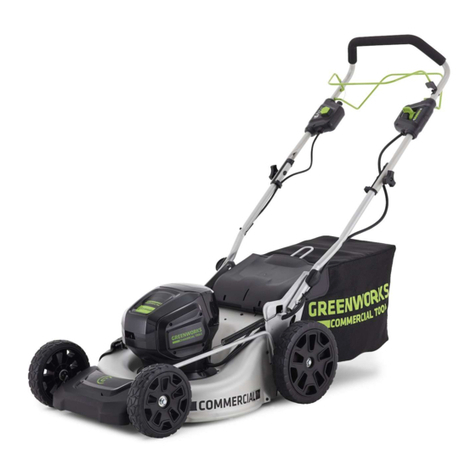
GreenWorks Commercial
GreenWorks Commercial 2502007 User manual

GreenWorks Commercial
GreenWorks Commercial CZ60R24X User manual


